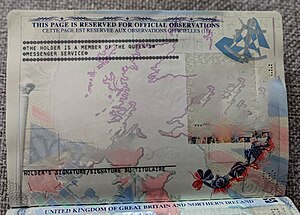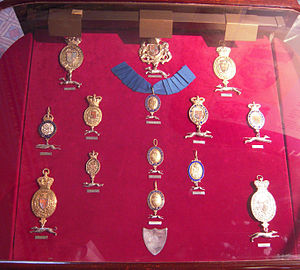King's Messenger



The Corps of King's Messengers (or Corps of Queen's Messengers during the reign of a female monarch) are couriers employed by the British Foreign, Commonwealth and Development Office (FCDO). They hand-carry secret and important documents to British embassies, high commissions, and consulates around the world. Many King’s Messengers were retired Army personnel. Messengers generally travel in plain clothes in business class on scheduled airlines with their consignment.
The safe passage of diplomatic baggage is guaranteed by Articles 27 and 36 of the Vienna Convention on Diplomatic Relations, and for reasons of state secrecy, the diplomatic bag does not go through normal airport baggage checks and must not be opened, X-rayed, weighed, or otherwise investigated by customs of a foreign state, airline security staff or anyone else.[dubious – discuss] The only exception is if there is serious evidence that it might contain materials prohibited or controlled by quarantine in the destination state.[1]: 8, 11 The King’s Messenger has the status of a diplomatic courier and cannot be detained by foreign governments. British diplomatic bags and King’s Messengers do not benefit from these immunities in the UK, and HMRC has the right to examine UK diplomatic bags.[2] The messenger and the messenger's personal luggage can be required to go through normal security screening.[1]
History
The formal role and title ‘Royal Messenger’, whether to King or Queen, is most certainly evident within the retinues of the English monarchy, certainly extending back to the early 12th century. They were termed 'Nuncii' or 'Cursores', depending on whether they travelled by horse or foot, and were well paid. Their role was sufficiently important that individuals with this role can be identified in records from the reigns of kings John, Henry III, and the first three Edwards.[3] They carried messages around England and to other countries on behalf of the government. They were the primary means for communication with local officials such as sheriffs and mayors and travelled in circuits so that the King and his staff had regular updates on the actions that had been commanded. They also sometimes transported money or valuables around the country.[4] The number employed was between 30 and 60.[4] : 67
A noted 15th-century King's Messenger was John Norman, who was appointed in 1485 by King Richard III to hand-deliver secret documents. During his exile, Charles II appointed four trusted men to convey messages to Royalist forces in England.[5] As a sign of their authority, the King broke four silver greyhounds from a bowl familiar to royal courtiers, and gave one to each man. A silver greyhound thus became the symbol of the Service.[5] On formal occasions, the King's Messengers wear this badge from a ribbon, and on less formal occasions male messengers wear ties with a discreet greyhound pattern while working.
In 1824 the messengers became a formal part of the UK Foreign Office.[6]
Modern day

Modern communications have diminished the role of the King's Messengers, but as original confidential documents still need to be conveyed securely between countries, their function remains valuable, but declining.
In 1995 a parliamentary question[7] put the number of Messengers then at 27. The number in March 2015 was sixteen full-time and two part-time, and the departmental headcount was nineteen.[8] In December 2015 an article in the Daily Express suggested that the Queen's Messenger service was "facing the chop by cost-cutting Foreign Office mandarins who see them as a legacy of a by-gone age".[9] However the service continues, as part of the secure logistics operation of FCDO Services, part of the Foreign Office.[10]
The British Rail Class 67 diesel locomotive 67005 bears the name Queen's Messenger.[11]
King's Messengers have been officially ratified by King Charles III. This happened in November 2022.[citation needed]
See also
- Diplomatic courier
- BSAA Star Dust was carrying a King's Messenger at the time of its disappearance.[12]
- SS Berlin was carrying Mr Herbert, a King's Messenger, at the time of its sinking.[13]
- The Queen's Messenger (TV drama)
References
- ^ a b "Vienna Convention on Diplomatic Relations 1961" (PDF). The United Nations. Archived (PDF) from the original on 17 May 2022. Retrieved 18 April 2021.
- ^ "DIPPRIV1100 - Diplomatic Privileges Manual - HMRC internal manual - GOV.UK". Archived from the original on 2021-10-01. Retrieved 2021-10-01.
- ^ Hill, Mary C. (1994). King's Messengers 1199-1377: A List of All Known Messengers, Mounted and Unmounted, who Served John, Henry III, and the First Three Edwards. Alan Sutton. p. 195. ISBN 0750907649.
- ^ a b Hill, Mary C. (1996). "The King's Messengers in England, 1199—1377". Medieval Prosopography. 17 (2): 63–96. JSTOR 44946235. Archived from the original on 18 April 2021. Retrieved 18 April 2021.
- ^ a b Mitchell, Keith (25 March 2014). "The Silver Greyhound - The Messenger Service". Prime Minister's Office. Archived from the original on 9 October 2015. Retrieved 5 February 2024.
- ^ "Our history". UK Government. Archived from the original on 17 April 2021. Retrieved 18 April 2021.
- ^ "Hansard". UK Parliament. Archived from the original on 18 April 2015. Retrieved 17 April 2015.
- ^ Freedom of Information Act 2000 Request Ref: FOI Ref: 0315 Archived 2015-10-29 at the Wayback Machine Letter from Foreign & Commonwealth Office, dated 27 April 2015
- ^ Giannangeli, Marco (5 December 2015). "Queen's Messengers face the axe, heroes who resisted all tyrants, honeytraps and pirates". Daily Express. Archived from the original on 20 October 2023. Retrieved 7 September 2016.
- ^ "King's Messengers". FCDOServices. UK Government. Archived from the original on 2 June 2023. Retrieved 18 April 2021.
- ^ Lockwood, Tasmin (7 December 2020). "What is the Royal Train? And everything else you want to know". The Northern Echo. Archived from the original on 18 April 2021. Retrieved 18 April 2021.
- ^ Bowcott, Owen (6 September 2002). "DNA clues reveal 55-year-old secrets behind crash of the Star Dust". The Guardian. Archived from the original on 26 August 2013. Retrieved 18 April 2021.
- ^ "The Berlin Disaster". Harwich and Dovercourt. Archived from the original on 18 April 2021. Retrieved 18 April 2021.
Further reading
- Antrobus, George Pollock, and Cecil Hunt. King's Messenger, 1918-1940, Memoirs of a Silver Greyhound. London: H. Jenkins, 1941.
- Bamber, Iain. From Pouch to Passport: A History of Kings & Queens Messenger Insignia. Mandurah, W.A.: DB Publishing, 2009.
- O'Brien-Twohig, Michael. Diplomatic Courier. Elek Books, 1960.
- Wheeler-Holohan, Vincent. The History of the King's Messengers. London: Grayson & Grayson, 1935.
External links
- Queen's Messenger Story 1952, British Pathe film, 7:42 mins. Can be viewed online
- FCDO link for the Queen's Messengers
